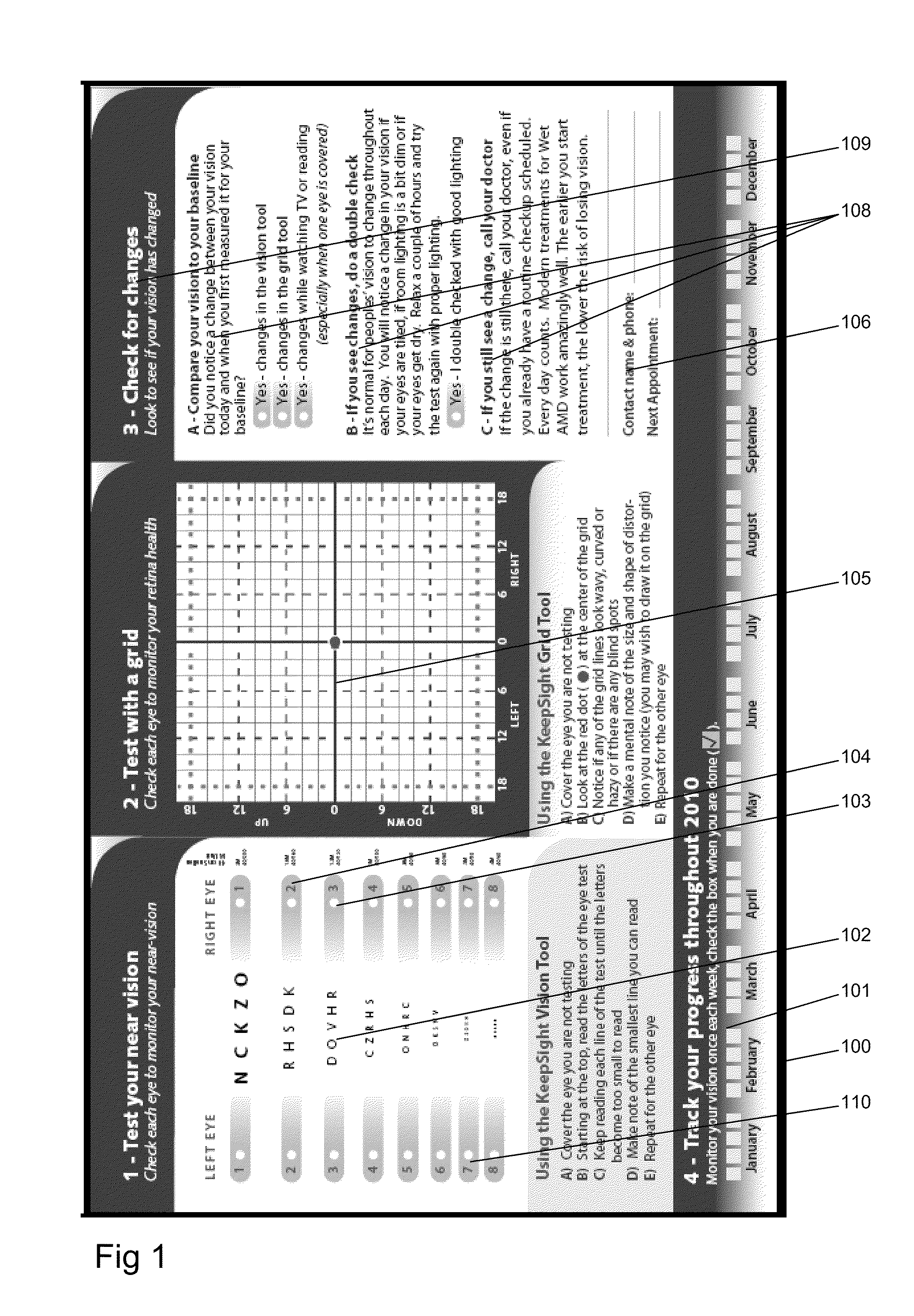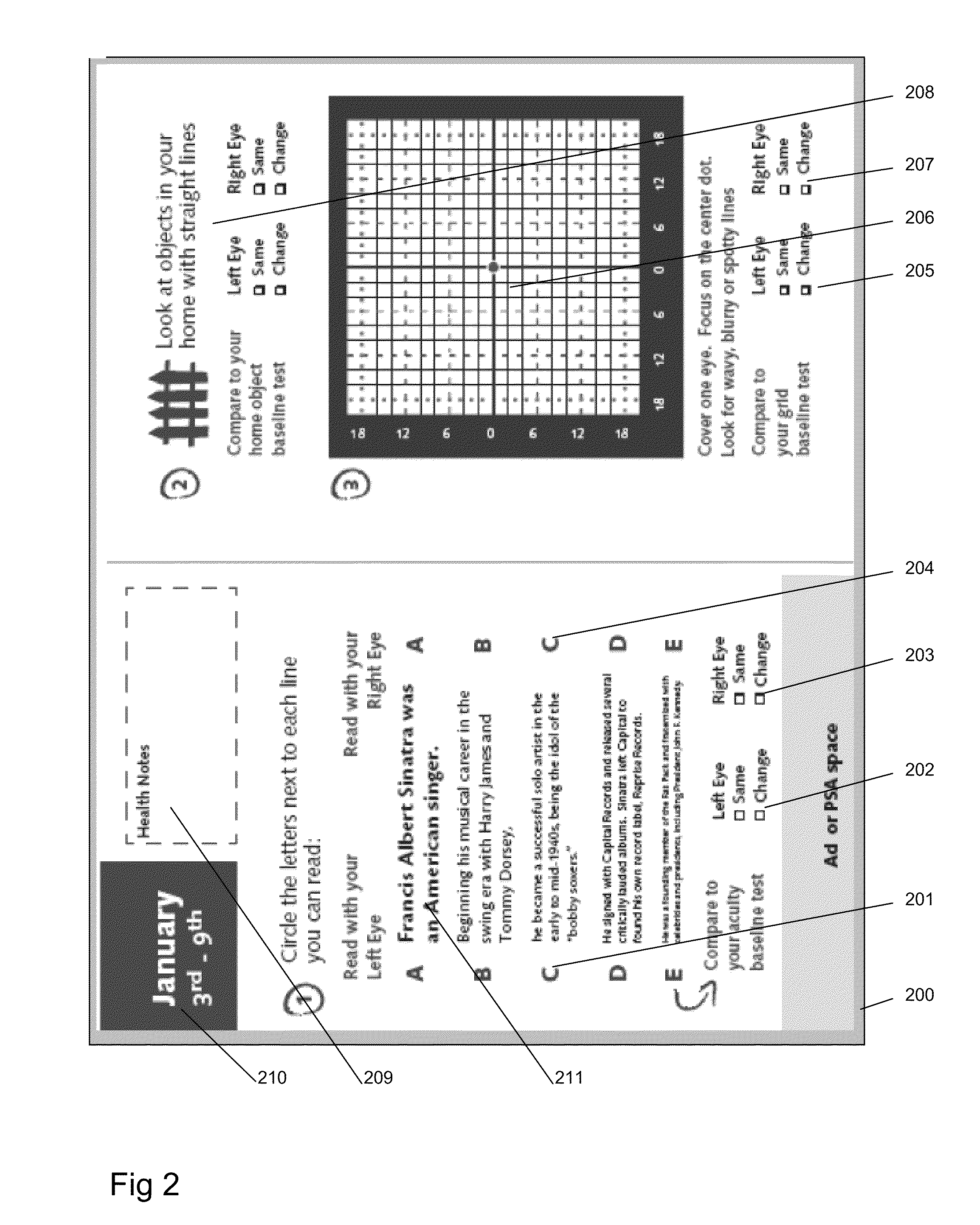Vision loss is disruptive to the individual affected, their family and society.
There are many causes of vision loss and vision impairment.
Current home self-monitoring tools for
retina diseases fail to adequately indicate a change in vision, resulting in
delayed treatment starts and higher incidences of severe vision loss.
Unfortunately, many people affected by these disorders suffer needlessly because they are either unaware of their condition or they do not respond to their symptoms with sufficient promptness.
This often leads to a
delay in presentation after the onset of a visual change, which creates a
delay in
clinical diagnosis and therefore a
delay in the start of treatment, which may lead to permanent and unrecoverable vision loss.
The Amsler and Yanuzzi grids, the only widely used self-tests for AMD, have proven largely ineffective at enabling patients to recognize the signs that they should consult their
retina specialist for treatment.
There are no other commonly available tools for patient self-monitoring in one's home between
office visits.
Shortcomings of the Amsler grid include but are not limited to: periodicity of the test pattern, lack of
individual adjustment, lack of visual & memory stimulating triggers, inability to overcome the visual completion phenomenon,
poor compliance, subjectivity, lack of quantification,
anxiety and doubt, relatively high levels of concentration required and
habituation.
However, the problem of late presentation persists and it is evident that there is a gap in the marketplace for novel solutions that deliver educational messages and self-monitoring tools that can help accelerate patient presentation for all forms of vision loss.
Thus, annual vision check-ups are not sufficient to protect patient's visual health; and diligent home self-monitoring is essential.
However, the current grid tests do not provide effective self-monitoring.
The result is that many people are needlessly suffering advanced vision loss and
blindness because they lack the ability to accurately and confidently monitor their vision and know when to accelerate their visit to their
eye care professional before their scheduled appointment date.
By waiting until their routinely scheduled exam date or not presenting until vision loss impacts
activities of daily living, people put their visual health at risk.
Each day that a patient delays the start of treatment may lead to worsening and often
irreversible loss of vision.
In clinical testing, the Amsler grid has not proven successful at enabling patients to detect issues nor to understand when to seek council of their
retina specialist.
“For scotomas of 6 degrees or less in
diameter, 77% of standard and 87% of threshold scotomas were not detected by Amsler grid testing.”“Amsler Grid reports have poor validity and cannot be accurately interpreted for use in the
clinical diagnosis of
retinal defects.”
“Results of two successive Amsler grid tests were not comparable, even when the technique was identical and time between tests was no more than 2 to 15 min.”“the Amsler grid technique is unreliable for evaluating central scotomas.”
. . difficulty with compliance .
. . problems with the subjective nature of the test.”, “Relatively high levels of concentration are needed to undertake the test .
Many patients are aware of their symptoms but don't have confidence in their self assessment to consider the changes to be significant; this leads them to question whether their vision is truly different than it was last week or the week prior allowing slow progression of vision loss to continue without triggering a help-seeking response.
Many patients are aware of their symptoms and have confidence in their self-assessment but do not respond with urgency, perhaps hoping vision will restore itself and simply waiting until their next scheduled eye exam to discuss the anomaly with their doctor; this can lead to situations where patient's inability to make a decision about seeking help wait until a dire consequence of functional
blindness before they feel the urgency to decide to seek help.
Many patients delay out of an inability to arrange an appointment with an eye doctor, either because of transportation issues, inability to master reimbursement questions, the need to attend to higher morbidity diseases, lack of a relationship with an eye care specialist, and others.
Lack of confidence in self assessment can frequently be attributed to shortcomings in the
standard of care in home vision monitoring—the Amsler grid.
The consequences of these impacts can lead to (but are not limited to) unnecessary delays in presenting to an eye care professional.
The implication to the eye care industry are many:1. Fewer patients receive intervention at the earliest stages of
disease (
drug therapy, corrective lenswear,
surgery, etc)2. Fewer patients fall within the treatable range of the
disease because many have progressed beyond acceptable treatable limits for first-line therapies, reducing the armamentaria available to the treating physician3. More patients fail to receive full benefit of their treatment, some find the treatment ineffective because they started late, and many lose significant vision4. Certain therapies that are used in late-presenting patients may not establish optimal
health outcomes if compared to a
scenario where more patients presented days or weeks earlier
Societal implications include, but are not limited to:1. Vision loss directly reduces a patient's ability to be a productive contributor to society2. Vision loss indirectly taps patient's family's ability to productively contribute to society3. Vision loss increases the need for social services and other governmental support4. Delayed presentation increases the extent of treatment required, increasing the monetary costs through public & private insurance programs
Few patients have the patience to measure the distance between their test and their eyes each time they use a test.
Samples of patients who have been interviewed have stated that they find use of a string to maintain proper distance as being cumbersome.
Thus, while this distance may not easily facilitate an absolute measure of vision, its consistency week over week is sufficient for conducting relative vision measurements.
Providing a reduced-
font Snellen-like test for in-
home use may have limited ability for the test to yield an absolute (ie: clinically repeatable and accurate) measure of acuity (because of variations in printing size, variations in the space between the eye and the test, inconsistency in use, improper lighting, improper use, etc).
Unfortunately, the success of a patient's ability to evaluate a change in
near vision acuity is dependent upon the patient's ability to compare a current reading with a reading taken at an earlier date.
Consequently,
near vision acuity tests such as reduced
font Snellen-like tests
pose a challenge in implementation for successful use in monitoring vision over time.
 Login to View More
Login to View More  Login to View More
Login to View More 


